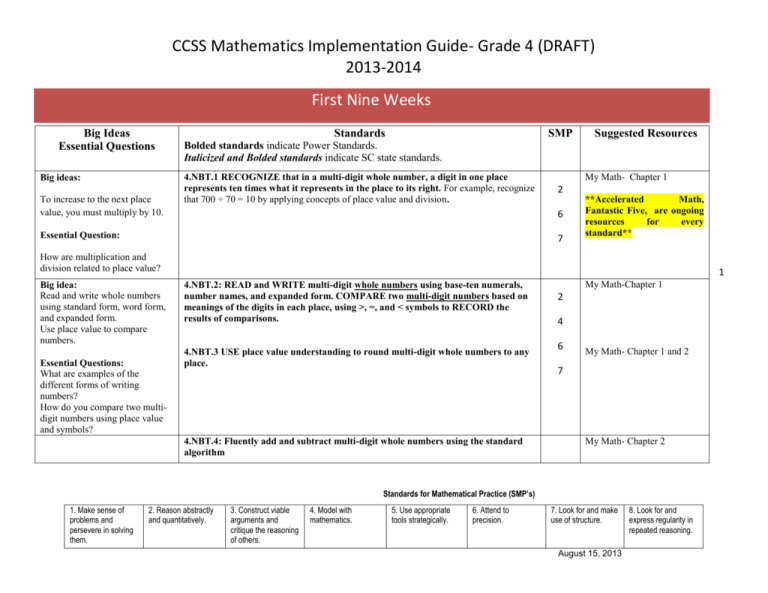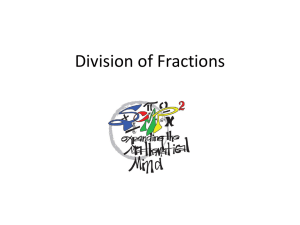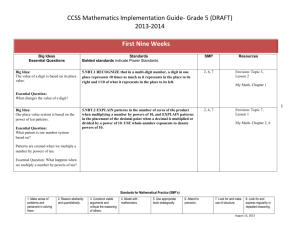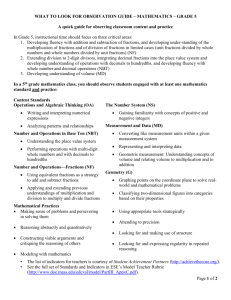Fractions (10 min.)
advertisement

CCSS Mathematics Implementation Guide- Grade 4 (DRAFT) 2013-2014 First Nine Weeks Big Ideas Essential Questions Big ideas: To increase to the next place value, you must multiply by 10. Standards SMP Suggested Resources Bolded standards indicate Power Standards. Italicized and Bolded standards indicate SC state standards. 4.NBT.1 RECOGNIZE that in a multi-digit whole number, a digit in one place represents ten times what it represents in the place to its right. For example, recognize that 700 ÷ 70 = 10 by applying concepts of place value and division. My Math- Chapter 1 2 6 Essential Question: 7 **Accelerated Math, Fantastic Five, are ongoing resources for every standard** How are multiplication and division related to place value? Big idea: Read and write whole numbers using standard form, word form, and expanded form. Use place value to compare numbers. Essential Questions: What are examples of the different forms of writing numbers? How do you compare two multidigit numbers using place value and symbols? 1 4.NBT.2: READ and WRITE multi-digit whole numbers using base-ten numerals, number names, and expanded form. COMPARE two multi-digit numbers based on meanings of the digits in each place, using >, =, and < symbols to RECORD the results of comparisons. 4.NBT.3 USE place value understanding to round multi-digit whole numbers to any place. 4.NBT.4: Fluently add and subtract multi-digit whole numbers using the standard algorithm My Math-Chapter 1 2 4 6 My Math- Chapter 1 and 2 7 My Math- Chapter 2 Standards for Mathematical Practice (SMP’s) 1. Make sense of problems and persevere in solving them. 2. Reason abstractly and quantitatively. 3. Construct viable arguments and critique the reasoning of others. 4. Model with mathematics. 5. Use appropriate tools strategically. 6. Attend to precision. 7. Look for and make use of structure. August 15, 2013 8. Look for and express regularity in repeated reasoning. CCSS Mathematics Implementation Guide- Grade 4 (DRAFT) 2013-2014 Big Ideas Essential Questions Big idea: -You can use adding, subtracting, multiplying, and dividing to solve word problems that have more than one step and unknown numbers. -All answers should be checked to see if it answers the question. -Use mental math and estimation to check answers. Standards SMP 4.OA.3 SOLVE multistep word problems posed with whole numbers and having whole-number answers USING the four operations, including problems in which remainders must be INTERPRETED. REPRESENT these problems using equations with a letter standing for the unknown quantity. ASSESS the reasonableness of answers USING mental computation and estimation strategies including rounding. My Math – Chapter 2 1 (Embedded in all chapters) 2 3 4 5 Essential questions: -How many steps will it take to solve a word problem? How do you know? -What operations will you use to solve a word problem? -How can you check your answers to make sure they make sense? Big idea: -Two factors multiplied together give you a multiple.. -A number can be prime if it has two factors (one and itself). -If a number is not prime, it is composite (more than two factors). Suggested Resources Bolded standards indicate Power Standards. 4.OA.1 Interpret a multiplication equation as a comparison, e.g., interpret 35=5x7 as a statement that 35 is 5 times as many as 7 and 7 times as many as 5. Represent verbal statements of multiplicative comparisons as multiplication equations. 4.OA.4 FIND all factor pairs for a whole number in the range 1-100. RECOGNIZE that a whole number is a multiple of each of its factors. DETERMINE whether a given whole number in the range 1-100 is a multiple of a given one-digit number. DETERMINE whether a given whole number in the range 1-100 is prime or composite. My Math- Chapter 3 7 2 8 My Math- Chapter 3 2 7 Essential question: -How do multiples and factors differ? -What is the difference between a prime and composite number? How do you know? Standards for Mathematical Practice (SMP’s) 1. Make sense of problems and persevere in solving them. 2. Reason abstractly and quantitatively. 3. Construct viable arguments and critique the reasoning of others. 4. Model with mathematics. 5. Use appropriate tools strategically. 6. Attend to precision. 7. Look for and make use of structure. August 15, 2013 8. Look for and express regularity in repeated reasoning. CCSS Mathematics Implementation Guide- Grade 4 (DRAFT) 2013-2014 Second Nine Weeks Big Ideas Essential Questions Standards Bolded standards indicate Power Standards. Big Ideas: You can use different strategies to multiply bigger numbers. Essential Questions: How would you solve this multiplication problem? Explain your answer. Big idea: You can use different strategies to divide bigger numbers. Essential Question: How would you solve this division problem? Explain your answer. Big Idea: -Multiplication and division can be used to solve word problems. -Using drawings and equations can help me solve a problem. -Symbols can be used to represent unknown numbers. SMP 4.NBT.5 MULTIPLY a whole number of up to four digits by a onedigit whole number, and MULTIPLY two two-digit numbers, USING strategies based on place value and the properties of operations. ILLUSTRATE and EXPLAIN the calculation by using equations, rectangular arrays, and/or area models. 4.NBT.6. FIND whole-number quotients and remainders with up to four-digit dividends and one-digit divisors, USING strategies based on place value, the properties of operations, and/or the relationship between multiplication and division. ILLUSTRATE and EXPLAIN the calculation by USING equations, rectangular arrays, and/or area models. 4.OA2: MULTIPLY or DIVIDE to SOLVE word problems involving multiplicative comparison, e.g., by USING drawings and equations with a symbol for the unknown number to REPRESENT the problem, DISTINGUISHING multiplicative comparison from additive comparison. Suggested Resources My Math- Chapters 3-6 2 3 4 5 7 AIMS – Marvelous Multiplication and Dazzling Division My Math- Chapters 3-6 2 3 4 5 7 AIMS – Marvelous Multiplication and Dazzling Division My Math- Chapters 3-6 2 4 5 7 AIMS – Marvelous Multiplication and Dazzling Division Real Life Math Series –Menu Math Essential questions: -Multiplication and division can be used to solve word problems. -Using drawings and equations can help me solve a problem. -Symbols can represent unknown numbers. Hands-on standards Lessons 11-12 Standards for Mathematical Practice (SMP’s) 1. Make sense of problems and persevere in solving them. 2. Reason abstractly and quantitatively. 3. Construct viable arguments and critique the reasoning of others. 4. Model with mathematics. 5. Use appropriate tools strategically. 6. Attend to precision. 7. Look for and make use of structure. August 15, 2013 8. Look for and express regularity in repeated reasoning. 3 CCSS Mathematics Implementation Guide- Grade 4 (DRAFT) 2013-2014 Big Ideas Essential Questions Standards Bolded standards indicate Power Standards. Big idea: -Patterns can be made using shapes and numbers. -Patterns follow a rule. Essential question: -How do you make a pattern using shapes or numbers that follows a specific rule? -How do you find a rule for a specific number or shape pattern? SMP 4.OA.5 GENERATE a number or shape pattern that follows a given rule. IDENTIFY apparent features of the pattern that were not explicit in the rule itself. For example, given the rule “Add 3” and the starting number 1, generate terms in the resulting sequence and observe that the terms appear to alternate between odd and even numbers. Explain informally why the numbers will continue to alternate in this way. 2 4 5 7 Safari Montage videos Suggested Resources My Math- Chapter 7 MOOB – Signs and Symbols Cyberchase: Patterns: The Poddleville Case (29 min.) Bill Nye: Patterns (23 min.) Number Patterns (15 min.) Standards for Mathematical Practice (SMP’s) 1. Make sense of problems and persevere in solving them. 2. Reason abstractly and quantitatively. 3. Construct viable arguments and critique the reasoning of others. 4. Model with mathematics. 5. Use appropriate tools strategically. 6. Attend to precision. 7. Look for and make use of structure. August 15, 2013 8. Look for and express regularity in repeated reasoning. 4 CCSS Mathematics Implementation Guide- Grade 4 (DRAFT) 2013-2014 Third Nine Weeks Big Ideas Essential Questions Big idea: Fractions can be equivalent even though they have different numbers. Multiplication can be used to create equivalent fractions. Standards Bolded standards indicate Power Standards. SMP 4.NF.1 EXPLAIN why a fraction a/b is equivalent to a fraction (n x a)/(n x b) by USING visual fraction models, with attendion to how the number and size of the parts differ even though the two fractions themselves are the same size. USE this principle to recognize and GENERATE equivalent fractions. 2 My Math- Chapter 8 4 Fraction Unit 7 Funny & Fabulous Fraction Stories 8 Essential Question: Safari Montage videos How can you show that two fractions are equivalent? Give an example. Suggested Resources Cyberchase: Fractions: Zeus on the Loose (29 min.) Fractions (10 min.) Equivalent Fractions & Mixed Numbers (15 min.) Big idea: Fractions can be compared by finding common numerators and denominators. Fractions can be compared using benchmarks. 4.NF.2 COMPARE two fractions with different numerators and different denominators, e.g., by CREATING common denominators or numerators, or by COMPARING to a benchmark fraction such as ½. RECOGNIZE that comparisons are valid only when the two fractions refer to the same whole. RECORD the results of comparisons with symbols >, =, or <, and JUSTIFY the conclusions, e.g., by using a visual fraction model. Fractions can be compared using symbols. My Math- Chapter 8 2 Fraction Unit 4 5 7 Essential Question: How can you compare two unlike fractions? Standards for Mathematical Practice (SMP’s) 1. Make sense of problems and persevere in solving them. 2. Reason abstractly and quantitatively. 3. Construct viable arguments and critique the reasoning of others. 4. Model with mathematics. 5. Use appropriate tools strategically. 6. Attend to precision. 7. Look for and make use of structure. August 15, 2013 8. Look for and express regularity in repeated reasoning. 5 CCSS Mathematics Implementation Guide- Grade 4 (DRAFT) 2013-2014 Big Ideas Essential Questions Big Idea: Fractions can be added or subtracted by joining or separating the parts. Standards SMP 4.NF.3a Understand a fraction a/b with a > 1 as a sum of fractions 1/b. a. UNDERSTAND addition and subtraction of fractions as joining and separating parts referring to the same whole. Essential Question: How can I add or subtract like fractions? Big Idea: A fraction can be separated into smaller parts. Essential Question: How do you break apart a fraction? Big Idea: An improper fraction can be written as a multiplication equation. Essential Question: What is another way to represent an improper fraction using multiplication? Suggested Resources Bolded standards indicate Power Standards. Italicized and Bolded standards indicate SC state standards. 1 My Math- Chapters 8-9 2 Fraction Unit 4-8 4.NF.3b. DECOMPOSE a fraction into a sum of fractions with the same denominator in more than one way, RECORDING each decomposition by an equation. JUSTIFY decompositions, e.g., by using a visual fraction model. Examples: 3/8 = 1/8 + 1/8 + 1/8 ; 3/8 = 1/8 + 2/8 ; 2 1/8 = 1 + 1 + 1/8 = 8/8 + 8/8 + 1/8. 4.NF.4a Apply and extend previous understandings of multiplication to multiply a fraction by a whole number. a. UNDERSTAND a fraction a/b as a multiple of 1/b. For example, use a visual fraction model to represent 5/4 as the product of 5 x (1/4), recording the conclusion by the equation 5/4 = 5 x (1/4). 1 My Math- Chapters 8-9 Fraction Unit 2 6 4-8 1 My Math- Chapters 8-9 Fraction Unit 2 4-8 Standards for Mathematical Practice (SMP’s) 1. Make sense of problems and persevere in solving them. 2. Reason abstractly and quantitatively. 3. Construct viable arguments and critique the reasoning of others. 4. Model with mathematics. 5. Use appropriate tools strategically. 6. Attend to precision. 7. Look for and make use of structure. August 15, 2013 8. Look for and express regularity in repeated reasoning. CCSS Mathematics Implementation Guide- Grade 4 (DRAFT) 2013-2014 Big Ideas Essential Questions Big Idea: Multiply fractions by whole numbers. Essential Question: Use a fraction model to show how to multiply a whole number time a fraction. Big Idea: Equivalent fractions from tenths to hundredths can be used to help in adding fractions. Essential Question: How do you find and add equivalent fractions with denominators of 10 and 100? Big Idea: Fractions with denominators of 10 and 100 can be written as decimals. Standards SMP Suggested Resources Bolded standards indicate Power Standards. 4.NF.4b UNDERSTAND a multiple of a/b as a multiple of 1/b, and USE this understanding to multiply a fraction by a whole number. For example, use a visual fraction model to express 3 x (2/5) as 6 x (1/5), recognizing this product as 6/5. (In general, n x (a/b) = (n x a)/b.) 1 My Math- Chapters 8-9 Fraction Unit 2 4-8 4.NF.5 EXPRESS a fraction with denominator 10 as an equivalent fraction with denominator 100, and USE this technique to add two fractions with respective denominators 10 and 100. For example, express 3/10 as 30/100, and add 3/10 + 4/100 = 34/100. 2 Fraction Unit 4 7 5 7 4.NF.6 USE decimal notation for fractions with denominators 10 or 100. For example, rewrite 0.62 as 62/100; describe a length as 0.62 meters; locate 0.62 on a number line diagram. Essential Question: How do you rewrite a fraction with a denominator of 10 and/or 100? 2 Envision – Topic 12 4 5 7 Standards for Mathematical Practice (SMP’s) 1. Make sense of problems and persevere in solving them. 2. Reason abstractly and quantitatively. 3. Construct viable arguments and critique the reasoning of others. 4. Model with mathematics. 5. Use appropriate tools strategically. 6. Attend to precision. 7. Look for and make use of structure. August 15, 2013 8. Look for and express regularity in repeated reasoning. CCSS Mathematics Implementation Guide- Grade 4 (DRAFT) 2013-2014 Fourth Nine Weeks Big Ideas Essential Questions Big Idea: You can draw and identify points, lines, line segments, rays, angles (right, acute, obtuse), and perpendicular and parallel lines. Standards SMP Suggested Resources Bolded standards indicate Power Standards. 4.G.1 DRAW points, lines, line segments, rays, angles (right, acute, obtuse), and perpendicular and parallel lines. IDENTIFY these in two-dimensional figures. 5 My MathChapters 11-12 6 Essential Question: Draw an example of each: points, lines, line segments, rays, angles (right, acute, obtuse), and perpendicular and parallel lines. Big idea: Use knowledge of the given measurement unit to convert large units to smaller units by multiplying. Essential question: How do you change large measurement unit into smaller measurement units? Big idea: -To solve word problems involving measurement using addition, subtraction, multiplication, or division. -Use diagrams to represent measurement quantities. 8 4.MD.1 KNOW relative sizes of measurement units within one system of units including km, m, cm; kg, g; lb, oz.; l, ml; hr, min, sec. Within a single system of measurement, EXPRESS measurements in a larger unit in terms of a smaller unit. RECORD measurement equivalents in a two-column table. For example, know that 1 ft is 12 times as long as 1 in. Express the length of a 4 ft snake as 48 in. Generate a conversion table for feet and inches listing the number pairs (1, 12), (2, 24), (3, 36), ... 4.MD.2 USE the four operations to solve word problems involving distances, intervals of time, liquid volumes, masses of objects, and money, including problems involving simple fractions or decimals, and problems that require expressing measurements given in a larger unit in terms of a smaller unit. REPRESENT measurement quantities using diagrams such as number line diagrams that feature a measurement scale. 2 My MathChapters11-12 5 6 1 2 4 My MathChapters 11-12 MOOB – Inside and Outside 5 Essential questions: -How can you use a diagram to show the answer to a measurement word problem? 6 Standards for Mathematical Practice (SMP’s) 1. Make sense of problems and persevere in solving them. 2. Reason abstractly and quantitatively. 3. Construct viable arguments and critique the reasoning of others. 4. Model with mathematics. 5. Use appropriate tools strategically. 6. Attend to precision. 7. Look for and make use of structure. August 15, 2013 8. Look for and express regularity in repeated reasoning. CCSS Mathematics Implementation Guide- Grade 4 (DRAFT) 2013-2014 Big Ideas Essential Questions Standards SMP Suggested Resources Bolded standards indicate Power Standards. My Math- Chapter 13 4.MD.3 APPLY the area and perimeter formulas for rectangles in real world and mathematical problems. 4.MD.4 MAKE a line plot to display a data set of measurements in fractions of a unit (1/2, 1/4, 1/8). Solve problems involving addition and subtraction of fractions by using information presented in line plots. Big idea: You can measure an angle in reference to a circle as a whole and the angles as a part. Essential question: How do you measure an angle in reference to a circle? My Math- Chapter 14 4.MD.5 RECOGNIZE angles as geometric shapes that are formed wherever two rays share a common endpoint, and UNDERSTAND concepts of angle measurement. 6 7 a. An angle is measured with reference to a circle with its center at the common endpoint of the rays, by considering the fraction of the circular arc between the points where the two rays intersect the circle. An angle that turns through 1/360 of a circle is called a “one-degree angle,” and can be used to measure angles. MOOB – Corners and Containers 9 Hands-on Standards lesson 6-7 b. An angle that turns though n one-degree angles is said to have an angle measure of n degrees. Standards for Mathematical Practice (SMP’s) 1. Make sense of problems and persevere in solving them. 2. Reason abstractly and quantitatively. 3. Construct viable arguments and critique the reasoning of others. 4. Model with mathematics. 5. Use appropriate tools strategically. 6. Attend to precision. 7. Look for and make use of structure. August 15, 2013 8. Look for and express regularity in repeated reasoning. CCSS Mathematics Implementation Guide- Grade 4 (DRAFT) 2013-2014 Big Ideas Essential Questions Big idea: Standards SMP Suggested Resources Bolded standards indicate Power Standards. 4.MD.6 MEASURE angles in whole-number degrees USING a protractor. SKETCH angles of specified measure. My Math- Chapter 14 2 Angles can be measured and drawn using a protractor. 5 Essential question: 6 MOOB – Corners and Containers What mathematical tool is used to measure and draw angles? Draw a 30 ̊ angle. Big idea: -You can find an unknown angle measurement by adding or subtracting angle parts. -You can write an equation for the unknown angle measure (symbol). 10 My Math- Chapter 14 4.MD.7 RECOGNIZE angle measure as additive. When an angle is decomposed into non-overlapping parts, the angle measure of the whole is the sum of the angle measures of the parts. SOLVE addition and subtraction problems to FIND unknown angles on a diagram in real world and mathematical problems, e.g., by USING an equation with a symbol for the unknown angle measure. Essential question: -How can you find an unknown angle measurement when two other related angle measurements are given? Write your answer as an equation. (80 ̊ is decomposed as a 30 ̊ + ? ̊) 1 2 MOOB – Corners and Containers 4 6 Standards for Mathematical Practice (SMP’s) 1. Make sense of problems and persevere in solving them. 2. Reason abstractly and quantitatively. 3. Construct viable arguments and critique the reasoning of others. 4. Model with mathematics. 5. Use appropriate tools strategically. 6. Attend to precision. 7. Look for and make use of structure. August 15, 2013 8. Look for and express regularity in repeated reasoning. CCSS Mathematics Implementation Guide- Grade 4 (DRAFT) 2013-2014 Big Ideas Essential Questions Big Idea: -Two-dimensional shapes can be classified by lines and/or angles. -A right triangle has one 90° angle. Standards SMP Suggested Resources Bolded standards indicate Power Standards. 4.G.2 CLASSIFY two-dimensional figures based on the presence or absence of parallel or perpendicular lines, or the presence or absence of angles of a specified size. RECOGNIZE right triangles as a category, and IDENTIFY right triangles. Essential Question: Observe the shapes, classify them according to their lines and angles. My Math- Chapter 14 5 6 7 Define and identify a right triangle. Big Idea: A line of symmetry will split a figure into two equal parts. 4.G.3 RECOGNIZE a line of symmetry for a two-dimensional figure as a line across the figure such that the figure can be folded along the line into matching parts. IDENTIFY line-symmetric figures and DRAW lines of symmetry. My Math- Chapter 14 4 5 Essential question: 6 How many lines of symmetry can a square have? 7 Standards for Mathematical Practice (SMP’s) 1. Make sense of problems and persevere in solving them. 2. Reason abstractly and quantitatively. 3. Construct viable arguments and critique the reasoning of others. 4. Model with mathematics. 5. Use appropriate tools strategically. 6. Attend to precision. 7. Look for and make use of structure. August 15, 2013 8. Look for and express regularity in repeated reasoning. 11









